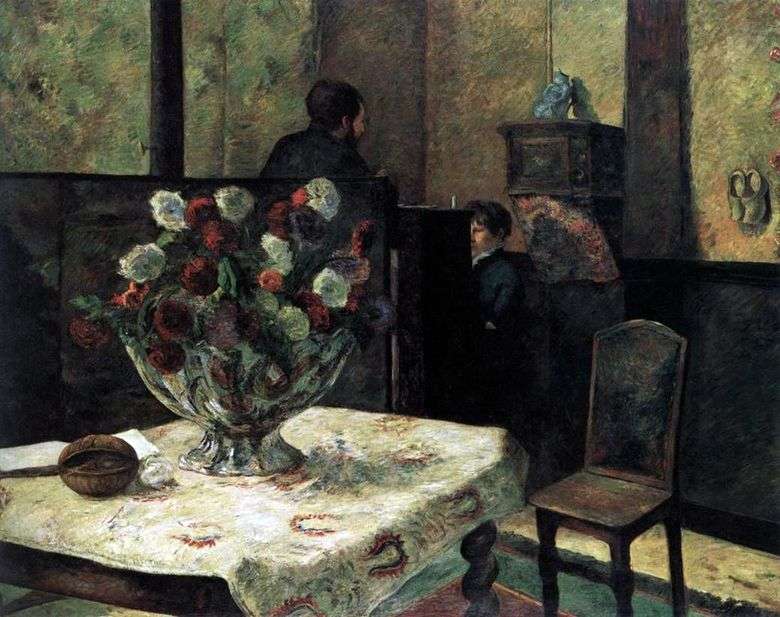
The work is very significant and unusual. This picture refers to the beginning of Gauguin’s work. Here we will not find either decorative, or a particular relation to color, nor planar images – none of the basic stylistic features of the painting of the great Gauguin. However, the canvas shows a sharp contradiction with academic traditions and enthusiasm for impressionistic theories.
“In the house on Karsel Street” we see an unusual story, rather, everything that happens is quite ordinary – someone is playing music at the piano under the strict guidance of a man hanging over the instrument, the very form of giving this scene is unusual here.
In the foreground, that is, in the focus of the viewer, Gauguin decided to portray as a matter of fact his secondary character – a vase with a lush bouquet. On the basis of the same event develops in the depths of the picture. Such a nomination of secondary objects is Edgar Degas’ favorite method.
But we should not consider the earlier works of Paul Gauguin only as an imitation of the leading Impressionist contemporaries. Already the early work of the future world-famous master was distinguished by its uniqueness and integrity.
Here and in the considered canvas the distinctive feature is light. The bright, dense light that pours from the foreground, spreading all over the canvas, illuminating the table, illuminating the room, it is precisely the unifying means by which the picture becomes complete.
The palette that Gauguin chose for this work is also unusual – they are calm colors, without the predominance of pure colors, which the artist will rely on in the future.
The painting “In the house on Karsel Street” is still an amateur work. The main earnings of Gauguin at that time was one of the most respectable stock exchanges in Paris, where Gauguin was attached by Gustave Arosa. Only a year after writing the submitted work, after the exchange crisis, Gauguin will finally make his choice in favor of painting. Having replaced the calm way and stable earnings, on the thorny path of the artist, complex and uneven.
 House of Hymns by Paul Gauguin
House of Hymns by Paul Gauguin Interior de la casa del artista en Ryu Karsel – Paul Gauguin
Interior de la casa del artista en Ryu Karsel – Paul Gauguin Portrait of Madame Gauguin in an Evening Dress by Paul Gauguin
Portrait of Madame Gauguin in an Evening Dress by Paul Gauguin Bathers by Paul Gauguin
Bathers by Paul Gauguin Landscape with peacocks by Paul Gauguin
Landscape with peacocks by Paul Gauguin House of Artists in Argenteuil by Claude Monet
House of Artists in Argenteuil by Claude Monet Whisper II by Paul Gauguin
Whisper II by Paul Gauguin Siesta by Paul Gauguin
Siesta by Paul Gauguin